“Watch it wiggle, see it jiggle, Jell-O brand Gelatin…” , and “There’s Always Room for JELL-O.”
These advertising slogans stick in many American minds.
Jell-O is the largest selling prepared dessert and is known worldwide. The brand name Jell-O is commonly used in the United States as a generic and household name for any gelatin product. I have been to many a potluck, picnic, BBQ’s, and family gathering where there is always a delicious Jell-O mold or salad provided. There is something about that sweet, cool, jiggly dessert with floating fruit and whipped cream topping that is so refreshing.
Many may be surprised to learn that the origins of JELLO-O is actually a protein produced from collagen (a gelatinous substance) that is extracted from boiling animal bones. The French were the first to use gelatin in cooking. The gourmet-minded French like their foods en gelee-aontnd their word for it is gelatine. The preferred spelling is without that final e, whether you’re referring to flavored or unflavored gelatin.
What is Jell-O?
Jell-O is sold ready to eat or in powder form, and is available in many different colors and fruit flavors. The powder contains powdered gelatin and flavorings, including sugar or artificial sweeteners. t is dissolved in very hot water, then chilled and allowed to set. Fruit, vegetables, whipped cream, or other ingredients can be added to make elaborate snacks that can be molded into various shapes. Jell-O must be put in a refrigerator until served, and once set properly, it is normally eaten with a spoon. – from Wikipedia.
History of Gelatin, Gelatine, and JELL-O:
The word “gelatine” comes originally from Latin word “gelatus” and means “jellied, froze.” Gelatine was first used in Egyptian times. Traces of gelatine were found in a pharaoh grave in the form of glue.
Gelatin was once considered a sign of wealth, before the advent of prepared gelatin, only members of the elite classes could afford it. It took hours to render gelatin, clarify it, and turn it into fancy aspics, molded salads, desserts. etc. The use of gelatin was a sign that the host or hostess had the means to support a kitchen staff with the skill and time to create such a dish. When gelatin became available commercially it still was a symbol of culinary sophistication.
1682 – History’s first references to gelatine:
A Frenchman named Denis Papin (1647-1712) recorded his research experiments on the subject. His experiments resulted in a method of removing the glutinous material from animal bones by boiling. It has no taste, no odor, and when combined with liquid, no color, but it is pure protein.
“A jellye made of bones of beef” was mentioned in the diary of Englishman John Evelyn (1620-1706) in 1682 when describing the results of a demonstration of the first pressure cooker.
1754 – The first English patent for the manufacture of gelatin was granted. I can find no proof of this.
1800 – 1815 – Nutritional value of gelatin was recognized as early as the Napoleonic Wars when the French used it as a source of protein during the English blockade.
1845 – Unflavored dried gelatin became available in 1842 from the J and G Company of Edinburgh, Scotland. The same year, the J and G Company began exporting its Cox’s Gelatin to the United States.
1845 – Peter Cooper (1791-1883), industrialist, inventor, and philanthropist, secured a patent (US Patent 4084) for a gelatin dessert powder called Portable Gelatin, requiring only the addition of hot water. Nothing was done with this patent for another fifty years. Mr. Cooper did not set out purposely to discover dessert gelatine. He was more interested in glue. For many years, food manufacturers experimented with gelatine but no one was able to come up with an appealing product. It looked bad and did not taste very good. While Cooper patented its manufacture, he did little to commercialize it. He packaged it for sales to cooks, but there was little interest. He sold the patent to Pearl Wait, a cough syrup maker, in 1895. inventor of the steam locomotive, secured a patent for a gelatin dessert powder called Portable Gelatin, requiring only the addition of hot water.
1874 – Hartley’s is a British brand makes and markets marmalades, jams and jellies. This brand was created by Sir William Pickles Hartley, and in 1874, the manufacture of jelly began.
1889 – Plymouth Rock Gelatin Company of Boston patented its Phosphated Gelatin in 1889.
1894 – Charles Knox developed the world’s first pre-granulated gelatine. He had watched his wife go through the long and difficult process of making gelatine and resolved to find an easier method. He experimented until he found a process that resulted in a product that was superior to any on the market. Knox packaged dried sheets of gelatin and then hired salesmen to travel door-to-door to show women how to add liquid to the sheets and use it to make aspics, molds, and desserts. In 1896, Rose Knox published Dainty Desserts, a book of recipes using Knox gelatin.
1895 – Pearl B. Wait, a cough-syrup manufacturer in Le-Roy, New York was having business troubles. He decided to give up the cough-syrup business and branch out to the food industry. He and his wife, May, experimented with adding fruit syrups (strawberry, raspberry, orange, and lemon) to gelatin. The powder was 88% sugar. May renamed the dessert “Jell-O.” However, they were also unsuccessful in selling the product. Unfortunately for Mr. Wait, he lacked the funds and knowledge to properly market his product, so he ended up selling the Jello-O formula to his neighbor, Orator Francis Woodward.
1899 – Orator Francis Woodward, purchased the Jello-O name and the business for $450. During the early years, Orator Francis Woodward had no luck getting Jell-O to take-off in popularity either and he reportedly tried to sell-off the Jell-O business for only $35 to his Plant Superintendent, Andrew Samuel Nico! Woodward’s advertising efforts started paying off when sending well-groomed salesmen out on beautiful horse-drawn carriages into communities, fairs, country gatherings, and church socials to evangelize and provide Jell-o samples. These efforts, along with new technologies such as refrigeration, and packaging in a powdered form helped Jell-O get discovered and became fashionable to serve at banquets and fancy dinners.
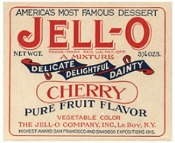 1902 – Woodward launched the advertising campaign, “America’s most favorite Dessert.” Pictures, posters and billboards and magazine ads providing Jell-o recipes were distributed all over the American landscape. Over 15 million Jell-o recipe booklets were printed and distributed into American households. Noted artists, such as Norman Rockwell even provided colored illustrations in these booklets to help make Jell-O a household word. In 1904 the JELL-O girl was introduced and in 1934, Jack Benny could be heard over the radio airwaves advertising “J-E-L-L-O”.
1902 – Woodward launched the advertising campaign, “America’s most favorite Dessert.” Pictures, posters and billboards and magazine ads providing Jell-o recipes were distributed all over the American landscape. Over 15 million Jell-o recipe booklets were printed and distributed into American households. Noted artists, such as Norman Rockwell even provided colored illustrations in these booklets to help make Jell-O a household word. In 1904 the JELL-O girl was introduced and in 1934, Jack Benny could be heard over the radio airwaves advertising “J-E-L-L-O”.
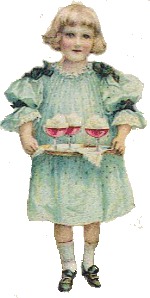 1904 – Jell-O introduces the Jell-O Girl, four year old Elizabeth King whose father, Franklin King, was an artist connected with the Dauchy Company – Jell-O’s advertising agency. In her right hand the little girl held a tea kettle and in her left a package of Jell-O. There tag line was “You can’t be a kid without it.”
1904 – Jell-O introduces the Jell-O Girl, four year old Elizabeth King whose father, Franklin King, was an artist connected with the Dauchy Company – Jell-O’s advertising agency. In her right hand the little girl held a tea kettle and in her left a package of Jell-O. There tag line was “You can’t be a kid without it.”
1923 – Woodward’s Genesee Pure Food Company was renamed JELL-O Company in 1923, and in 1925 merged with Postum Cereal, Inc, that would eventually become General Foods Corporation. Today Jell-O is owned and manufactured by Kraft/General Foods. Photo courtesy of Kraft/General Foods.
1927 – Chocolate Jell-O was introduced and discontinued in 1927
1930 – Jell-o came out with the now very popular lime jell-0.
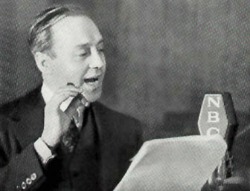 1934 – Advertising kept abreast of the times and so in 1934 General Foods, a pioneer in selling by radio, signed Jack Benny and the whole world came to know “J-E-L-L-O.”
1934 – Advertising kept abreast of the times and so in 1934 General Foods, a pioneer in selling by radio, signed Jack Benny and the whole world came to know “J-E-L-L-O.”
1936 – Chocolate returned to the Jell-O lineup as an instant pudding made with milk. The pudding became so popular that other pudding flavors were added such as vanilla, tapioca, coconut, pistachio, butterscotch, egg custard, flan and rice pudding.
1942 – The Southern Coca-Cola Salad was introduced at some point by replacing part of the liquid in the congealed salad with small bottles of Coca Cola. It became so popular that Jello-O introduced, very briefly, a cola flavored gelatin. It did not go over very well though.
1950’s – The Jell-O shot which mixes in alcohol (vodka or rum) for up to half the liquid portion of the Jello recipe is claimed to be invented by Tom Lehrer, an American Singer – Songwriter, as a way to get around the alcohol restrictions at the Army based he was stationed at.
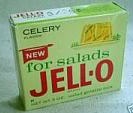 1960’s – Jell-O released savory and vegetable flavors such as celery, Italian (vegetable and seasoned tomato). Popular Jell-O recipes of the day included ingredients like cabbage, celery, green peppers, and even cooked pasta. The savory flavors have since been discontinued.
1960’s – Jell-O released savory and vegetable flavors such as celery, Italian (vegetable and seasoned tomato). Popular Jell-O recipes of the day included ingredients like cabbage, celery, green peppers, and even cooked pasta. The savory flavors have since been discontinued.
1964 – Advertising slogan “There’s always room for Jell-O” was introduced to promote the product as a “light dessert” after a heavy meal.
1974 – Jell-O sales were on the decline as working mom’s with young children were not purchasing Jell-O anymore. An advertising campaign was launched to reintroduce Jigglers which were Jell-O snacks molded into fun shapes that could be eaten as finger food. This campaign helped Jell-O sales to rise back up.
2001 – Utah State Representative, Leonard M. Blackham, introduced State Resolution 5, Resolution Urging Jell-O Recognition. The legislation was passed with only two dissenting votes, and Jell-O became the official Utah state snack food.
JELL-O is especially popular among members of The Church of Jesus Christ of Latter-day Saints, also referred to as Mormons. Sales’ figures released by Kraft Foods revealed that Salt Lake City, UT to have the highest per-capita JELL-O consumption. The Mormon Corridor region in Utah has been nicknamed the “Jell-O Belt.” JELL-O is believed to be popular among Mormons since the members have strong family values.
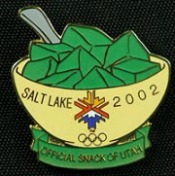 2002 – Green Jell-O Olympic commemorative pin for the 2002 Winter Olympics. The pin featured a big bowl of green Jell-O. The pin quickly sold out and became a hard to find collectible. Pin collecting is an Olympic sport that not too many people may be aware of is pin collecting and trading. According to some pin aficionados, collecting the pins is as exciting as the games themselves.
2002 – Green Jell-O Olympic commemorative pin for the 2002 Winter Olympics. The pin featured a big bowl of green Jell-O. The pin quickly sold out and became a hard to find collectible. Pin collecting is an Olympic sport that not too many people may be aware of is pin collecting and trading. According to some pin aficionados, collecting the pins is as exciting as the games themselves.
Interesting JELL-O Trivia:
In the 1939 movie, The Wizard of Oz, the horse that changed colors was actually six (6) horses sponged down with JELL-O.
In the early 1900s, the company decided to offer Ellis Island immigrants a bowl of Jell-O as “Welcome to America” gift!
During an air show at the Woodward Airport in Oklahoma, one of the contests involved having the pilot land his plane, run up to a table and eat a bowl of JELL-O, and then run back to the plane and take off.
In 1993, technicians at St. Jerome Hospital in Batavia, New York, tested a bowl of lime JELL-O with an EEG machine and confirm and confirmed the earlier testing by Dr. Adrian Upton that a bowl of wiggly Jell-O has brain waves identical to those of adult men and women.
The first four Jell-O flavors were orange, lemon, strawberry, and grass. Obviously through the years grass as a flavoring has disappeared from the American palate.
JELL-O is a brand recognized by 99% of Americans and used regularly in 72% of homes.
Gelatin is used by synchronized swimmers to hold their hair in place during their routines as it will not dissolve in the cold water of the pool. It is frequently referred to as “knoxing,” a reference to Knox brand gelatin
Sources:
JELL-O, Wikipedia – http://en.wikipedia.org/wiki/Jell-O
Fascinating Facts About the Invention of JELL-O, by Pearl B. Wait In 1897 – http://www.ideafinder.com/history/inventions/jello.htm
Jell-o History, The JELL-O Gallery, Le Roy, New York – http://www.jellogallery.org/history.html
History of Knox Brand, Kraft Foods – http://www.kraftbrands.com/knox/knox_history.html
JELL-O: A JIGGLY HISTORY, by Patent Home – http://patenthome.com/2012/08/jell-o-a-jiggly-history/
On The History of Gelatin, by Joe Pastry – http://www.joepastry.com/2010/on_the_history_of_gelatin/
History of Gelatine – http://jelly.e-monsite.com/pages/in-english/cultural-part/history-of-gelatine.html
Golden Age Spotlight on Advertising, The Digital Deli – http://www.digitaldeliftp.com/LookAround/advertspot_jello.htm

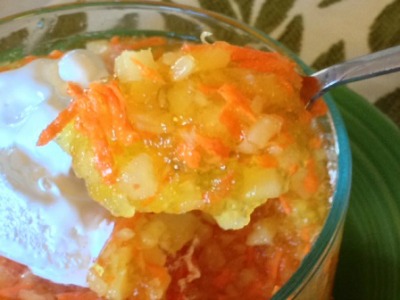
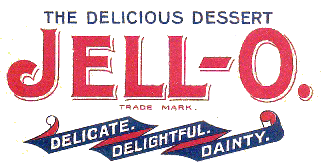
24 Responses to “History of Gelatin, Gelatine, and JELL-O”
ccynthia Kerr
How come we do not see the jello 1 2 3 anymore my favorite flavor was cherry
Whats Cooking America
Thanks for recalling a classic! We’ll have to feature this retro recipe. Here’s basic instructions on the Kraft website: http://www.kraftrecipes.com/recipes/jell-o-1-2-3-dessert-91448.aspx
mary l stokosa
i wish we had a bigger choice 0f flavors.
it would be helpful when I go for my colonoscopy.I cant eat the red or dark blue colors. the only colors we have in CT is red orange and sometime lemon , and if it is the right season??? green
Lynne Belluscio
I am the Director of the LeRoy Historical Society and author of one of your citations. I just want to set the record straight. Peter Cooper did not sell his patent to Pearle Wait. We have no clue where Pearle Wait got the idea to package powdered gelatin, flavoring, coloring and sugar. We are also not sure it was in conjunction with his patent medicine business. Even his granddaughter – who is still alive – – does not know. We do know that in 1897 – – not 1895 which you have stated – – was when Pearle Wait started packaging Jell-O. He registered the trademark in 1897. One story – – again not substantiated – – was that he had tasted Tryphosa – and decided he could market something similar. There were other flavored gelatins on the market before Jell-O as you mentioned. I often tell people that if you go to someone’s house and they say they are having Jell-O for dessert and give you chocolate pudding you say – – wait a minute I thought we were having Jell-O – – well Jell-O makes chocolate pudding too. At one time it made ice cream power with the Jell-O brand on it. Another thought – – no one ate Jell-O before 1897. And in the south, it is a “congealed salad.”
Saundra Fulce
where can I find strawberry crème Jell-O instant pudding mix? I can’t find them in stores any more. Can I order a case direct from the company?
Catherine Bracco
My great granddaughter has Type 1 diabetes and I make her pops with the sugar free jello. Why don’t the blue jello come sugar free I know she would love blue pops.
Payton Major
I really enjoyed this but It didn’t answer my question: Who created celery flavored Jell-O?
Linda Clouatre
Hi
I was wondering if the company had thought of bringing back the CARAMEL pie filling/ instant pounding ….. I remember my mom making it with warm milk and put in a graham pie crust . Please let me know …can’t wait to sink my taste buds back in my past .
Linda
Susan Robert
I grew up in the 50’s always had jello products.I remember a couple products that were out for a short time. One product was called Whip n chill, the other product was called Three player Jello, they would be considered Retro Products.
Christine
I have a Plymouth Rock White Gelatine that has never been opened. I can’t find any information about it online. When I google search as well as etsy, pinterest and ebay the only thing close is the red package of gelatin. Can anybody help me?
Elizabeth
Do you have a reference for your assertion that “the first four Jell-O flavors were orange, lemon, strawberry, and grass. Obviously through the years grass as a flavoring has disappeared from the American palate.” Records indicate that the first four flavors were Orange, Strawberry, Raspberry, and Lemon. These were the four flavors available prior to Genesee Pure Food Company and at the time Genesee Pure Food Company began producing Jell-O. Savory flavors like celery and vegetable were added more than 50 years later and were short lived.
Grass jelly is a common food, but is not made with gelatin. It is a plant based, vegetarian product while gelatin uses animal proteins. While most common in regions of Asia, grass jelly has a global presence including in the diets of Americans.
Whats Cooking America
Our research sources are listed as the bottom of the article.
Uma Yokeeswaran
Hi,
I think a good idea that can appeal to consumers would be making jello into fruit snacks. You have majority of the components you need to make a fruit snack as well as the flavors. You can even use the same shapes like the molds that they would be prepared in to remind people of the shape. Just an idea worth trying. Thanks
Amy NW
Please Please Please bring back 1-2-3 Jell-O
Julie Smith
I have read several articles that Jello is going to discontinue selling many of the Jello products is this true?
Alesa Miller
I was wondered if the Cook and Serve Tapioca pudding is still being manufactured? My mom is trying to find it and it’s “sold out” or not available anywhere.
SUSAN HUMPHEYS
I CANT FIND COOK & SERVE COCONUT OR LEMON JELLO ANYWHERE NEAR WHERE I LIVE CAN I ORDER IT FROM THE COMPANY? ITS MY HUSBAND FAVORITE & HIS BIRTHDAY IS COMING UP & HE ASKED FOR ME TO MAKE A COUPLE OF PIES INSTEAD OF A CAKE. THANK YOU FOR THE INFO
Molly Magby
I always make my 88 year old mom a lemon pie for Christmas. This year may be (2020) may be her last Christmas and no lemon pie. because I could not find Cook and Serve lemon pudding.
Went o every store in town none to be found. She was so disappointed
Says it’s just Not the same with out lemon pie.
Please tell me where I can get it.
Thank you.
Lori Lieto
Good evening. I was just sitting here reminiscing about my childhood and remembered jello pudding pops. They were so good! Any chance they can make a comeback? Just a thought.
Michele Wirth
Where’s all the sugar free vanilla heat & serve pudding???? Is it still being produced???
Susan Castledine
Has Jello stopped making Jell-O Ready-to-Eat Sugar Free Dulce de Leche Pudding Snacks? I love it and I can’t find it anywhere.
Kerry Guglielmotti
Is the sugar free individual jello cups not being made anymore, and if they are, why am I unable to find them in any grocery store?
Thank you,
Kerry
Kathryn
I’ve been searching everywhere for “lemon cook & serve “ pie filling . Can’t find it anywhere. I live in Florida.
Holly
What year did Jell-O start putting it in cups? My young niece and my daughter were making Jell-O valcanos. When I removed the Jell-O from the cup so perfectly she asked me if I had Jell-O cups as a kid. I had to think… I may not have. Thus is my search for the answer